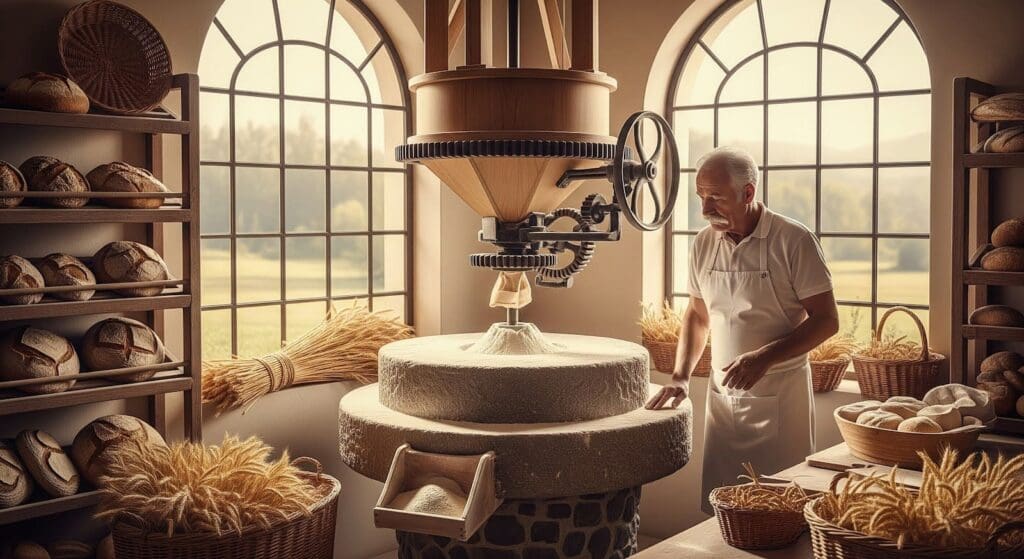When it comes to choosing the right flour, bakers—especially those using organic flour—often find themselves torn between two traditional methods: stone-ground flour and roller-milled flour. These two milling processes differ in equipment or technology, but they also impact the flavor, texture, and nutritional value of the baked goods you produce.
Various grains and flours are also available, influencing your choice between stone-ground and roller-milled flour.
Let’s break down each flour type’s key differences and benefits to help you decide which one belongs in your kitchen.
Flour milling is essential to transforming whole grains into flour, the foundation of countless breads and baked goods. There are two primary methods of milling: traditional stone milling and modern steel milling. Stone milling uses large, circular stone mills to slowly grind wheat and other grains, preserving the grain’s full nutritional value and natural flavor. This gentle process results in a more textured, nutrient-rich milled flour highly valued by artisan bakers and home enthusiasts.
On the other hand, steel milling relies on powerful steel rollers to crush the grain, producing an excellent flour with a consistent texture. While this method is efficient for mass production, it often removes some of the grain’s natural components, such as the bran and germ, which can reduce the nutritional content.
Whole wheat flour, made from the entire wheat grain, is especially prized for its higher fiber and nutrient content. Freshly milled flour, produced just before baking, is gaining popularity for its vibrant flavor and superior texture. Whether baking bread or experimenting with different grains, understanding the milling process can help you choose the best flour for your recipes and nutritional needs.

Wheat flour comes in several varieties, each suited to different baking needs. Whole wheat flour is made from the wheat grain, including the bran, germ, and endosperm, making it rich in fiber, nutrients, and a hearty, nutty flavor. This type of flour is ideal for rustic breads and recipes where nutrition is a priority.
All-purpose flour is a versatile blend of hard and soft wheat flours, offering a balance of protein and texture that works well for a wide range of baking applications, from cookies to cakes to breads. Bread flour, milled from hard wheat, contains a higher protein content, which helps create the strong gluten structure needed for chewy, well-risen loaves.
Stone-milled flour, produced using traditional stone grinding methods, stands out for its coarser texture and robust, nutty flavor. Many artisan bakeries favor stone-milled flour for its unique character and the depth it brings to breads and other baked goods. Each wheat flour type offers distinct benefits, so choosing the right one depends on your recipe and desired outcome.

Stone-ground flour is produced using stone milling, an age-old technique where two large circular stones slowly crush the grain. This gentle grinding action preserves the whole kernel, including the bran, germ, and endosperm, resulting in a more nutrient-dense milled flour. Stone milling is often a more coarse, hands-on process favored by artisan bakers. During the stone milling process, grains are poured into the hopper, which holds and feeds them into the stones for grinding. After milling, sifting can be used to adjust the texture and bran content of the flour.
Stone-ground flour production begins with organic wheat grown by dedicated farmers who prioritize quality and sustainability. The wheat is carefully cleaned and then slowly ground between two large stones, preserving the grain’s natural fiber, protein, and nutrients. Unlike factory-milled flours, stone-milled flour retains more of the wheat’s healthy components, resulting in a flour that’s both nutritious and flavorful.
The resulting flour is known for its rich, complex flavor and slightly coarser texture, making it a favorite among artisan and health-conscious bakers. Stone-milled flour is often used in various breads, pastries, and other baked goods, where its nutritional value and unique taste can truly shine. By choosing stone ground flour, you support organic farmers and enjoy a product as close to nature as possible.

Many bakers have tasted the difference in flavor and aroma when using stone-ground flour compared to conventional options.
Baking with stone-milled flour—especially whole wheat flour or heirloom varieties like Red Fife or spelt—yields a more rustic, wholesome loaf. It’s ideal for recipes focused on whole grains and high nutritional value.

In contrast, roller-milled flour is made using industrial machines that crush grain between rotating steel rollers. The sifting process in roller milling removes more bran and germ, resulting in a whiter, more refined flour. This mass production method eliminates the bran and germ, producing excellent flour with a long shelf life and predictable baking performance.
While it lacks the rich flavor and dense nutrition of stone-ground options, roller-milled organic flour is often sifted to produce a product with reliable results, perfect for bakers who prioritize precision.
Properly storing freshly milled flour is crucial for maintaining its quality, flavor, and nutritional value. Freshly milled flour, especially whole wheat flour, contains natural oils and moisture, making it more susceptible to spoilage than aged or store-bought flour. Store your fresh flour in an airtight container in a cool, dark place, away from heat and moisture, to keep it at its best. This helps preserve the flour’s flavor and prevents the loss of valuable nutrients.
If you don’t plan to use your freshly milled flour within a few days, consider storing it in the freezer to extend its shelf life and maintain its nutritional value. Always check your flour for any signs of spoilage, such as off smells or discoloration, before using it in your recipes. Storing your fresh flour properly ensures that every loaf, pastry, or bread you bake is as flavorful and nutritious as possible.

When you bake with stone-ground flour, you’re working with fresh flour full of nutrients, natural oils, and fiber. Dough made with stone-ground flour may require mixing time and hydration adjustments to develop proper gluten structure. Bakers often need to mix the dough more thoroughly when using stone-ground flour to improve elasticity and gas-trapping ability. Using stone-ground flour can also enhance the flavor and activity of a sourdough levain, making it more robust and adaptable. The result is often a denser crumb and more complex flavor—great for hearty sourdough, whole grain pastries, and other rustic bakes.
While more refined, roller-milled flour is often enriched to replace lost nutrients. It creates a lighter texture and is easier to handle, especially in recipes that rely on delicate doughs or refined crumb structure.
If you’re buying store-bought flour, check the label—some flours labeled “stone ground” may still be partially refined. For full benefits, look for 100% whole grain flour or grind your flour from whole berries using a home mill.
The answer depends on your baking goals:
Sourcing grains directly from a local farmer can improve the quality and traceability of your flour. Some bakers also like to incorporate larger pieces of cracked grain into their bread for added texture. Remember that there are differences between fresh and aged flour—aged flour has a shorter shelf life and can affect dough strength and flavor.
You might even consider keeping both on hand—use stone-ground wheat flour for hearty bread and roller-milled organic flour for lighter pastries or cakes.
Pro Tip: To experiment, try blending stone- and roller-milled flour in your recipe. You can enjoy the best of both worlds: the flavor and nutrition of whole grains with the structure of fine flour.









Sign Up for Exclusive Updates, Current Events, Recipes, and Special Offers and more!